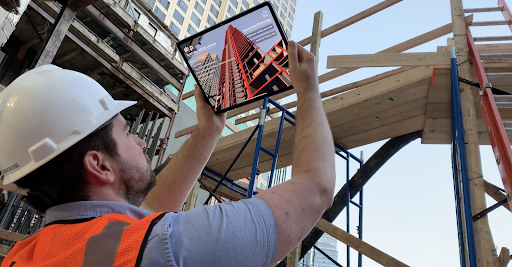What can Unity do?
Tutorial
·
foundational
·
+10XP
·
30 mins
·
(28379)
Unity Technologies

In this tutorial, you’ll learn about the different types of content that can be created with the Unity Engine. By the end of this tutorial, you'll be able to:
- Define the term "real time".
- Describe how real-time creation software is used in different industries.
- Identify a variety of real-time creators by their usage of Unity or their job role.
- Explain what a real-time game engine is and how it is used.
Languages available:
1. Overview
Unity is an interactive content creation platform. While it’s best known as a tool for making games, it has been embraced by many different industries for its flexibility and ease of use.
In this tutorial, you’ll learn about a few different industries that use Unity, and how they use Unity in their day to day work.
2. What is "real-time"?
Unity is a real-time engine, which allows for experiences that are fully interactive — not just for the end- user, but for the creator as well. Unity allows creators to quickly iterate and collaborate on a project with their colleagues, which speeds up the development process and helps the team arrive at a finished product that fully meets the needs of the user.
The term real-time describes how quickly an image is rendered (or displayed) on the screen, even as you're changing it. The goal of real-time software is to render images so quickly that you can freely interact in a virtual environment without any noticeable delay.
Although it's easy to take real-time interaction for granted today, in our games and other applications, it wasn't always the norm. In the past, computers weren’t powerful enough to quickly render visually complex scenes with physically accurate lighting and effects. In fact, a single still image might take several minutes, hours, or even days to render. Iterations were very costly, and experimentation was almost unheard of. New ideas that might improve the final product were often ignored for the sake of meeting the deadline.
Real-time technology grew out of video games to meet the demand for interactivity. Early real-time applications were able to sacrifice visual quality, animation complexity, and special effects. As computer processors have evolved, real-time has increased in quality, yielding the real-time photorealistic images in today’s games.
Today, real-time 3D has changed not only video game development, but many other industries as well. Watch the video below to hear how real-time 3D has transformed the way people design, build, and innovate.
3. What industries use Unity?
Unity is not limited to any specific industry — any industry that needs to create content, especially interactive content, benefits from creating with Unity. Every day, new and unique experiences created with Unity hit the market. Below are a few examples of the larger industries that use Unity to create their content.
Games
In the games industry, real-time technology means that games can be developed easier and faster than ever before. Game developers can work in real-time using the Unity Editor, or even build games right on their phones using Struckd.
Real-time technology allows game developers to work rapidly in real-time. But it also gives them a lot more artistic choices — they can achieve real-world visual accuracy, or they can design stylized worlds with non-realistic lighting and physics. Watch the video below for a sampling of the broad range of styles available to today's real-time game developers.
Since its release in 2005, Unity has been used to create thousands of games across 20 different platforms. Made With Unity (MWU) games make up around 50% of what’s available on PC, console, and mobile platforms today, and about 60% of platforms in the emerging XR (Virtual, Augmented, and Mixed Reality) gaming world. So, if you enjoy playing games, the odds that you’ve played a game Made With Unity are overwhelming!
Media and Entertainment
Media and Entertainment (M&E) includes several different but closely related industries, such as Film, Animation, and advertising. Unity greatly decreases the time it takes to create films and animations by allowing artists and animators to see their creations come to life in real time, saving on render time and allowing studios to release high quality content faster.
Architecture, Engineering, and Construction

The Architecture, Engineering, and Construction (AEC) industry literally builds the world around us. With Unity, these companies combine traditional design and building techniques with cutting edge technology, allowing them to design faster and build more efficiently and safely.
Watch the video below to learn how companies that design and build some of the world's most innovative structures use Unity and real-time 3D.
Automotive, Transportation, and Manufacturing

Real-time 3D has transformed the way automobiles and other vehicles and machines are designed, manufactured, and sold. For example, automotive engineers use Unity’s VR capabilities to create product designs and factory floor mockups that speed up iteration time and significantly lower development costs. Also, automotive marketers create real-time configurators with Unity that allow customers to view and customize photoreal 3D products and visualize them in a variety of dynamic environments while shopping online.
Watch the video below to see a compilation of applications for Unity in the automotive industry.
4. Experience Unity in action
The best way to learn about something is to experience it for yourself! We’ve created an application that will allow you to experiment with five different use cases in different industries. While these are small examples, they represent real applications in these fields today. While you’re exploring the app, try to identify the differences and similarities in the ways these industries use Unity. How does Unity help them? What does Unity seem particularly good at, based on your experience?
5. Next steps
Unity is used in many industries in many different ways, but what they all have in common is the need to see, understand, or interact with physical objects in virtual spaces, making the unreal real. To that end, creators create with Unity in just about every industry and job sector, and more are discovering the potential of real-time creation every day. In virtual space, anyone can make anything — all they need is Unity and an idea.
In the next tutorial, you’ll learn how professionals use Unity in their day-to-day work as you explore the real-time production cycle.